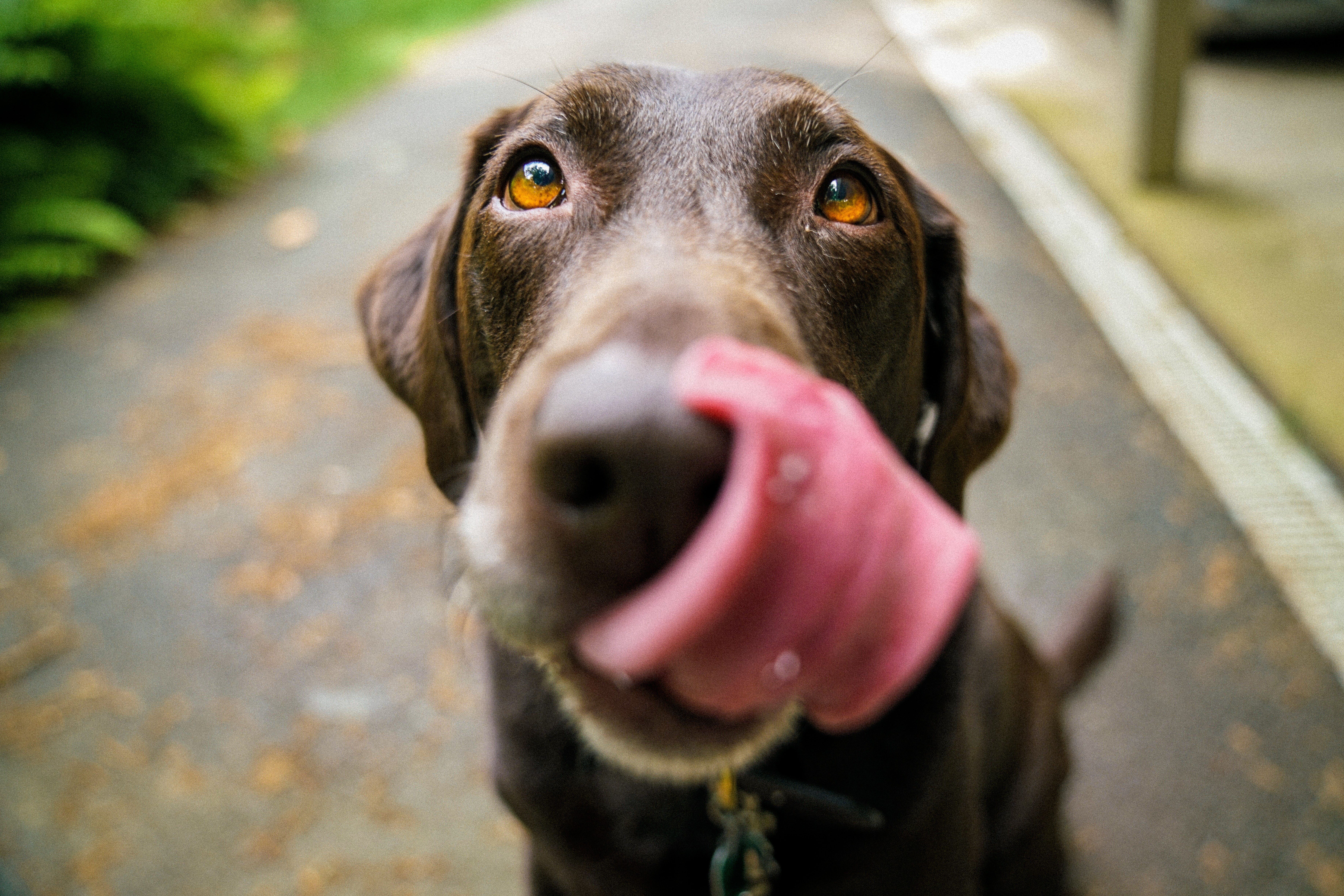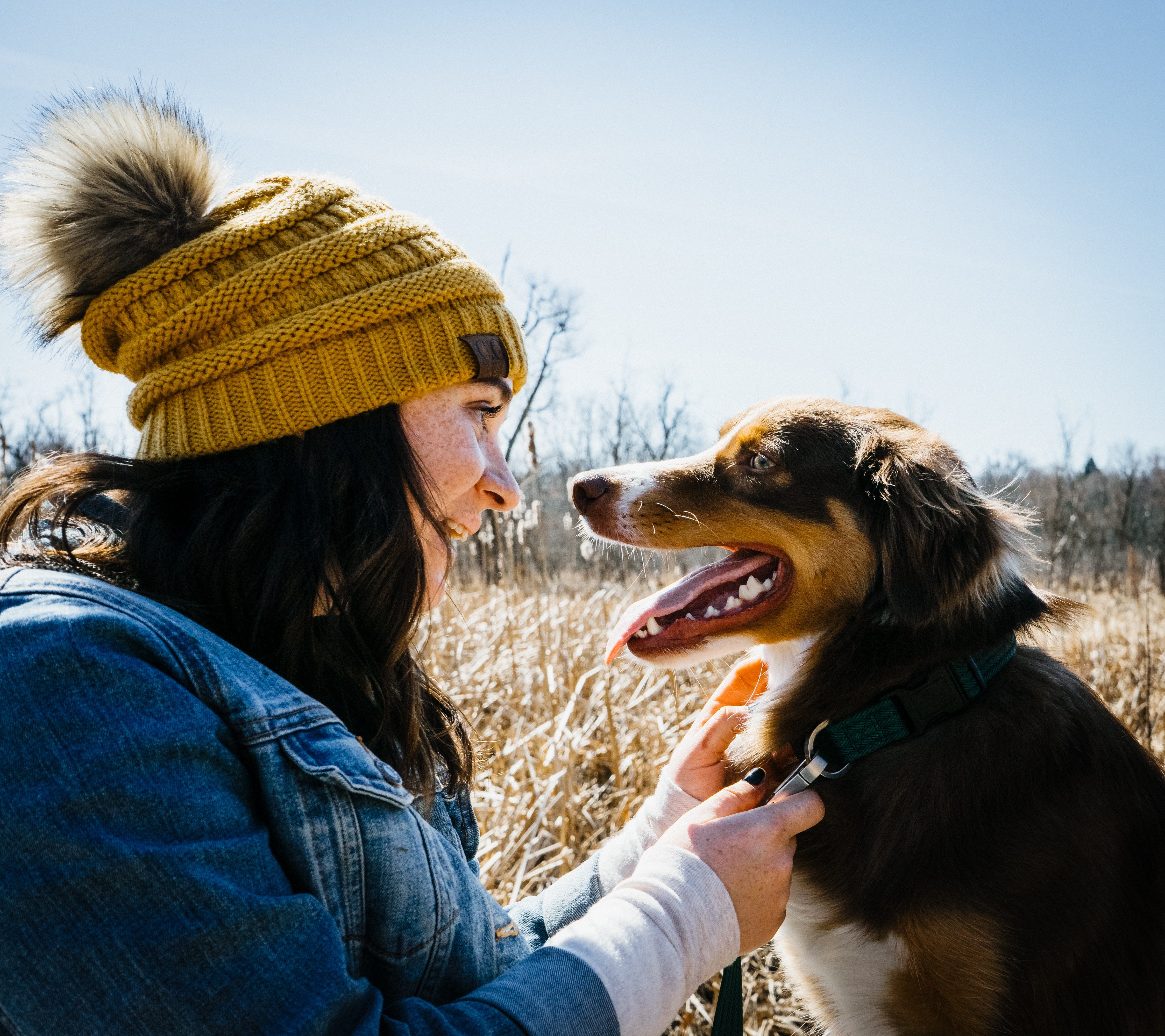And what it tells us about an ancient relationship

“What is it about dogs that makes intelligent men, gifted women — great minds — look at them and say [in baby-talk voice], ‘Who’s a good boy? . . . Wooj a whajeejeeb?’”
– Stephen Colbert
In her fascinating book, Our Dogs, Ourselves: The Story of a Singular Bond, Alexandra Horowitz, one of the world’s leading dog cognition scientists, begins a chapter about how people talk to their dogs with this quote from Stephen Colbert. Her aim in the chapter is to document the things people say to their dogs to shed some much-needed light on this little-explored area of cross-species communication.
In my field of research, sociolinguistics, we study the ‘social stuff’ people do with language: things like what social things motivate people to make the language choices they do, or how people use language to create social relationships with other human beings. But I also wonder about how people use language to build social relationships with non-human beings, like dogs.
There is a fair amount of research exploring how people talk about animals, for example, in different times throughout history, or in art and in literature. But surprisingly, there is much less research on how people actually talk to animals.
One reason may be that we view language use with dogs as mostly a one-way street, Perhaps this lack of research is because, as Horowitz points out, talking to dogs comes so naturally to people and is taken so much for granted in daily life that we hardly even realize we’re doing it. So we don’t think about it too much.
From my experience walking around my own neighborhood, people talk to their pets constantly. It seems to be a pervasive thing we do. This begs the question: What do we actually say to our dogs? What does talking to our dogs tell us about how we humans understand what it’s actually like to be a dog? And what do dogs make of all the things we say to them?
Determined to better understand the phenomenon of dog talk, Horowitz set out to document ––eavesdrop on rather — the many interesting and strange things people say to their dogs while walking with their dog companions through New York City streets. Every day, while walking her two dogs, Horowitz equipped a notebook and observed the human-dog interaction unfolding all around her. Here are a few things she overheard people say to their dogs:
“What are you even doing? I don’t understand you.
(Woman to her very sniffy black-and-white dog)”“You are B-A-D. (Woman to possibly keen-spelling dog)”
“Buddy, you can’t stop in the middle of the street. (Man to loitering dog)”
“Seriously? (Woman to long-peeing dog)”
“Go get the ball! Get the ball! Get the . . . Okay. I’ll get it. (Woman to non-retrieving retriever)”
Horowitz writes, “Historically, the language spoken to animals reflects the biblical notion of dominion, of man’s place above animals. Talk is telling or commanding, not asking or wondering.” Commands to horses like ‘giddyup’ or to dogs like ‘sit!’ are not about making conversation, but about commanding and disciplining behavior.
But in her observations of naturally occurring dog talk on the streets, people were engaging dogs in all sorts of (one-sided?) conversation, not just talking at them but seemingly with them. As a scientist, Horowitz began to notice patterns emerging in the hundreds of observations of dog talk she jotted down.
Parentese
The quote above from Stephen Colbert offers one example of ‘motherese’ or ‘parentese’ that Horowitz notes are common speech patterns in dog talk. In the field of developmental linguistics which explores how children acquire their first language(s), motherese or parentese refers to the register of speech parents use to speak to pre-verbal babies. Sometimes called ‘baby talk,’ when talking to babies, parents often talk in a higher pitch, slow the rate of their speech, and talk in short, simplified phrases:
Horowitz notes that speaking to a dog with motherese/parentese likely stems from the wide-spread (“but incorrect”) stereotype “that dogs have roughly the intelligence of two-year-old children; young couples may consider getting a dog as a trial run for having children.”
But it turns out there’s a notable difference in how we talk to baby humans and dogs, says Horowitz:
“Talk to puppies (or grown puppies) differs in other ways: when speaking to infants, we hyperarticulate our vowels: exaggeratedly saying Look at the doggeeeeee! to babies — but not nearly as much to dogs. It’s a subtle but key difference that marks a rift in our ways of thinking about kids and pups.”
The reason for this difference, Horowitz suggests, is that, there is a pedagogical function in the parentese we use with human babies. The speech patterns parents use with babies appear to emphasize aspects of language we want babies to pay attention to, and learn. This is because we view pre-verbal human babies to be on a developmental track to full-fledged fluency in their native languages.
Dogs, on the other hand, are not expected to become proficient language speakers like human babies, whether as English-speakers, Japanese-speakers, or Finnish-speakers. As Horowitz puts it, “when we are talking to dogs, we are under no illusion that they will grow up to use the language themselves. So we do the attention-getting, positive-affect parts of baby talk, but drop the schooling.”

“Talking The Dog” As A Conversational Resource For Humans
Horowitz also found in her observations that talking to dogs serves as a social lubricant for starting up conversations, or diffusing tense situations with other humans: “when we talk to dogs around others, it serves as a social lubricant, a way to open up the possibility of talking to each other. What’s your name? said dog-ward is never, never answered — except, obligingly, by a dog’s owner.”
Horowitz cites a study by the linguist Deborah Tannen entitled Talking the Dog: Framing Pets as Interactional Resources in Family Discourse. In the study, Tannen asked two families to audio-record their conversations at home, with the aim of researching the differences between language use at work and at home.
But after listening back to the recordings the families gave her, Tannen soon discovered that quite a bit of talk included the families’ pet dogs. Tannen describes how family members ‘ventriloquize’ their pets' voices: not just talking to their dogs, but talking for them as if they were voicing the dog’s point of view. For example, here is one conversation between Clara, Jason (Clara’s young son) and Tater (the dog):
Jason: I’m gonna put some of Tater’s toys in there…Where’s Tater’s toys?
Clara:(high-pitched) Tater, he’s even puttin’ your toys away! Tater says, (funny voice) “Yes, I never put them away! I consider my family to be a slew of maids, servants.”
Tannen notes how Clara accomplishes two goals by ‘ventriloquizing’ Tater’s point of view: In part, Clara is able to create an identity for Tater as a full-fledged family member (albeit a fairly arrogant family member who views his human family as ‘servants’). At the same time, Clara is able to use her anthropomorphic voicing of Tater to praise her son, Jason, for cleaning up his toys. Praise delivered ‘through’ the dog.
But at other times, ‘talking the dog’ can also be used for other purposes, like criticizing family members, or lightening the mood after an argument. For example, Tannen writes about one such interaction involving an argument between a couple:
“A couple who live together are having an argument. The man suddenly turns to their pet dog and says in a high-pitched, baby-talk register, “Mommy’s so mean tonight. You better sit over here and protect me.” This makes the woman laugh — especially because she is a petite 5 ft, 2 in.; her boyfriend is 6 ft, 4 in. and weighs 285 lb.; and the dog is a 10-lb. Chihuahua mix.”

Speaking to others through dogs across cultures
Diffusing an uncomfortable situation by talking to or ‘through’ a dog appears to be a wide-spread practice across cultures too. For instance, the linguist Samuel Gyasi Obeng conducted a fascinating study of dog-naming practices among the Akan of Ghana.
“I asked the young man what the puppy’s name was and he responded that the puppy was not his but that its owner called it Di woße aszm ‘Mind-your-own-business’. An old woman in the van immediately retorted “Yei dee enye owura yi assm a obisaee nti na wose aboa yi de saa yi?” [Isn’t it because of what this gentleman asked, that’s why you’re giving this animal that name?]. The young man immediately responded by saying “enye agoro na meredi. Ne din ara ne no” [I’m not making fun of any one. That’s its real name.]”
After a bit more research in the village, Obeng discovered an interesting naming practice among the Akan. The Akan believe a child has two sets of parents, one’ss biological parents and one’s spiritual parents who live in the spirit world, and who have control over a child’s fate. Earthly parents can communicate to spiritual parents through the name they give to the child. Obeng writes:
“like a personal name, a dog’s name can be used to communicate a reaction to an accusation, an insult, a quarrel, or a tragedy. It could also be an appeal to God for divine Intervention, a means of telling society of an individual’s awareness of a social problem, a warning, an appeal, a message about poverty, a sign of frustration, and so forth.”
For example, a woman who wanted to communicate to her ex-husband that she was in much happier marriage named her new dog ‘ware-Pa’ or ‘Good Marriage.’ Some other names that people had given their dogs: Merenka-Hwee (I’ve given up on words), Yenyaa-woo,(Beware of hypocrites), and Sensiaso, a shortened version of a local expression meaning: ‘The community must now be satisfied since the “Evil” it wished for me has eventually befallen me.”

Another interesting category of dog-directed talk Alexandra Horowitz found included people asking ‘Forever Unanswered Questions.’ Questions like: “What, are you reinventing the poo?” asked by a Woman marveling at her dog’s lengthy poo, or “Am I still interesting?” spoken by a “Woman to puppy, interested in something else.”
We seem content to ask our pets questions that go ‘forever unanswered.’ With my dogs, I realize I say fairly often, “what’s up buddy? what’s up buddy?” What do I mean by this? Are these ‘forever unanswered questions’ more like what the anthropologist Bronislaw Malinowski (1884–1942) calls ‘phatic communication,’ language not meant to gain or share a message other than saying, “hey, I’m here for you”:
“phatic communion serves to establish bonds of personal union between people brought together by the mere need of companionship and does not serve any purpose of communicating ideas.”
— Bronislaw Malinowski
Towards the end of her chapter, Horowitz mentions a survey showing that two-thirds of North American dog owners say daily to their dogs, “I love you.”
The historian of science, Donna Haraway reflects on her relationships with her dog Cayenne in her book When species meet. She wonders how love entangles people and dogs together in webs of responsibility. Or as she phrases it, ‘response-ability.’
In other words, relationships of love depend on our ability to respond and to do that, we need to be in tune with what the other wants, whether that other is a human or a dog. But is there a danger we might become blind to who dogs are because of our overly anthropomorphic talk to them, projecting our needs, thoughts, and desires onto their wildly different worlds?
“Knowing and living with these dogs means inheriting all of the conditions of their possibility, all of what makes relating with these beings actual, all of the prehensions that constitute us as companion species. To be in love means to be worldly, to be in connection with significant otherness and signifying others, on many scales, in layers of locals and globals, in ramifying webs.”
— Donna Haraway, in When Species Meet
Merlin Sheldrake, in his book Entangled Life, writes that “Anthropomorphism is usually thought of as an illusion that arises like a blister in soft human minds: untrained, undisciplined, unhardened. There are good reasons for this: When we humanize the world, we may prevent ourselves from understanding the lives of other organisms on their own terms.”
I think this is a very important point: anthropomorphizing animals can blind us to our ability to better understand their actual experience of the world, and be able to respond to their needs responsibly. But the opposite end of the spectrum — that animals are like machines acting out thoughtlessly on an instinct-based script, and without rich cognitive and emotional lives — is not scientifically correct either. “One is too simple, too pat; the other defies logic, defies science,” says Horowitz.
So we might ask when we talk to our dogs, is it just us humanizing dogs? Or are we also being ‘canine-ized’ by our dogs too? Do we also make sense of who we are, as human beings, through a dog’s point of view? What might we learn about being human by paying closer attention to people, looking at dogs, looking at people?
“Does your dog love you? Watch them, and you tell me.”
– Alexandra Horowitz, in “Our Dogs, Ourselves.”
Comments
Post a Comment